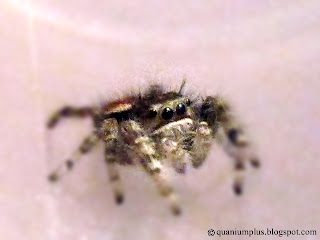 |
| Jumping Spider's Eye Patterns |
 |
| Anterior view Platycryptus undatus |
Genus Platycryptus
Species undatus
Common Name: Tan Jumping Spider
 |
| Lateral view of Platycryptus undatus |
Location:
Most in Eastern half of South America
Size:
Adult: ~10 mm
Habitat:
Meadow, bark woods,
Times:
Summer, probably hibernate during winder
Foods:
Insects and arachnids
Foods:
Insects and arachnids
Biological Characteristics
The compound eyes allow the spiders to look 360 degrees which provide them a better chance to catch preys and escape from predators. As other jumping spiders, this species does not make web to catch prey but using the specialized jumping technique to catch prey, which is more effective. All jumping spiders have poison glands in chelicerae, and their venom are not harmful to human,
_________________________________________________________________________________
 |
| Anterior side of Phidippus californicus |
Genus Phidippus
Species californicus
Common Name: Unknown
Location: In California, Arizona, Oregon, and Utah
Size:
Female: 12 mm
Male: 7-11 mm
Habitat:
Commonly found on bushes , avoid conifers.
 |
| Posterior side of Phidippus californicus |
April, May, June, July, and August.
Foods:
Insects and arachnids.
Biological characteristics:
Similar with other jumping spiders, it has 8 legs. However, the female may be confused with Phidippus johnsoni. These spiders are active during dusk and walking on the branches or stopping at the tips. They always build the silk for retreating purpose not hunting preys. Males are normally found during April to July and females are found during May to July. Females usually lay two batches of eggs. Each batch contains lesser eggs. For instance, 40 for the first, 30 for the second, and lesser.
References
Species Phidippus californicus. n.d. In BugGuide.com.
Retrieved from http://bugguide.net/node/view/65892/tree
Arana (Phidippus californicus). n.d. In iNaturalist.org. Retrieved from

No comments:
Post a Comment